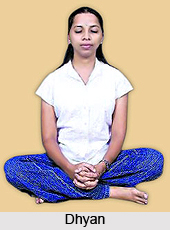 Sadhana Pada is the second chapter of Patanjali Yoga Sutra, where Patanjali comes down to the level of those who are not spiritually evolved. It is in this chapter that Maharshi Patanjali explains ways to aspire for the absolute freedom. In Sadhana Pada, he also elucidates the concept of Kriya Yoga. Kriya meaning action and Kriya Yoga, the yoga of action, has three tiers, namely tapas, svadhyaya and Isvarapranidhana. Tapas means burning desire, Savadhyaya means self study and Isvarapranidhana that means surrender to God. When these three aspects of Kriya Yoga are followed with generosity, life's sufferings are overcome and Samadhi is experienced. Sadhana Pada is the second chapter of Patanjali Yoga Sutra, where Patanjali comes down to the level of those who are not spiritually evolved. It is in this chapter that Maharshi Patanjali explains ways to aspire for the absolute freedom. In Sadhana Pada, he also elucidates the concept of Kriya Yoga. Kriya meaning action and Kriya Yoga, the yoga of action, has three tiers, namely tapas, svadhyaya and Isvarapranidhana. Tapas means burning desire, Savadhyaya means self study and Isvarapranidhana that means surrender to God. When these three aspects of Kriya Yoga are followed with generosity, life's sufferings are overcome and Samadhi is experienced.In Sadhana Pada, Patanjali also explains the causes of sufferings and the process to minimize it. He then explains the eightfold path of Yoga to achieve freedom for common man. This eight fold path is known as Astanga Yoga and it is suitable for all. The eight steps of Astanga Yoga are yama, niyama, asana, pranayama, pratyahara, dharna, dhyana and samadhi. Yamas are social moral conduct; Niyamas are to be followed strictly for self-development; Asana is a relaxed, steady and peaceful posture to make the physical body strong and ready for inward journey; Pranayama is the controlling of bio-energy. The first four steps are external supports and are called Bahiranga and last three are internal aid called Antaranga. Pratyahara is the association between external and internal. It consists of controlling of five sense organs. In the Sadhana Pada chapter, Patanjali explains the journey from yama to pratyahara. Sadhana Pada is the stage when a sadhaka who practices, applying his mind and intelligence with skill, dedication and devotion, attains the success of sadhana. Samadhi Pada prescribes a certain level of sadhana for those of balanced mind and stable spiritual attainment. In Sadhana Pada, the beginners are told how to begin their sadhana and work towards spiritual liberation. Here, the art of practice, abhyasa, is fully laid out to uphold the sadhaka in the uninterrupted maintenance of his sadhana; to guide him around pitfalls so that he may gain great clarity by acute observation and reflection and immaculate care in practice. Sadhana Pada, therefore, carries the torch for both the morally evolved and the uninitiated. It teaches the complete beginner how he may rise, through his sadhana, to the level of high aspirants. In this chapter, Patanjali also introduces Kriyayoga, the yoga of action. Kriya Yoga gives us the practical disciplines needed to scale the spiritual heights. Sadhana is a discipline undertaken in the quest of a goal. Affliction is the Diseases of the Mind There are five afflictions, namely worldly or erroneous knowledge (avidya), desire and attachment (raga), sense of 'I' ness (asmita), dislike (dvesa) and attachment to life and fear of death (abhinivesah). Pain and sorrow (duhkha) result from the affliction (klesha) of dislike (dvesha). The prime cause of afflictions is avidya or the failure to understand the coincidence between the seer and the seen or better said purusa and prakrti. The external world attracts the seer towards its pleasures, creating desire. The inevitable non-fulfillment of desires in turn creates pain that suffocates the inner being. Nature and her beauties are there for enjoyment and pleasure (bhoga) and also for freedom and emancipation (yoga). If we use them indiscriminately, we are bound by the chains of pleasure and pain. |